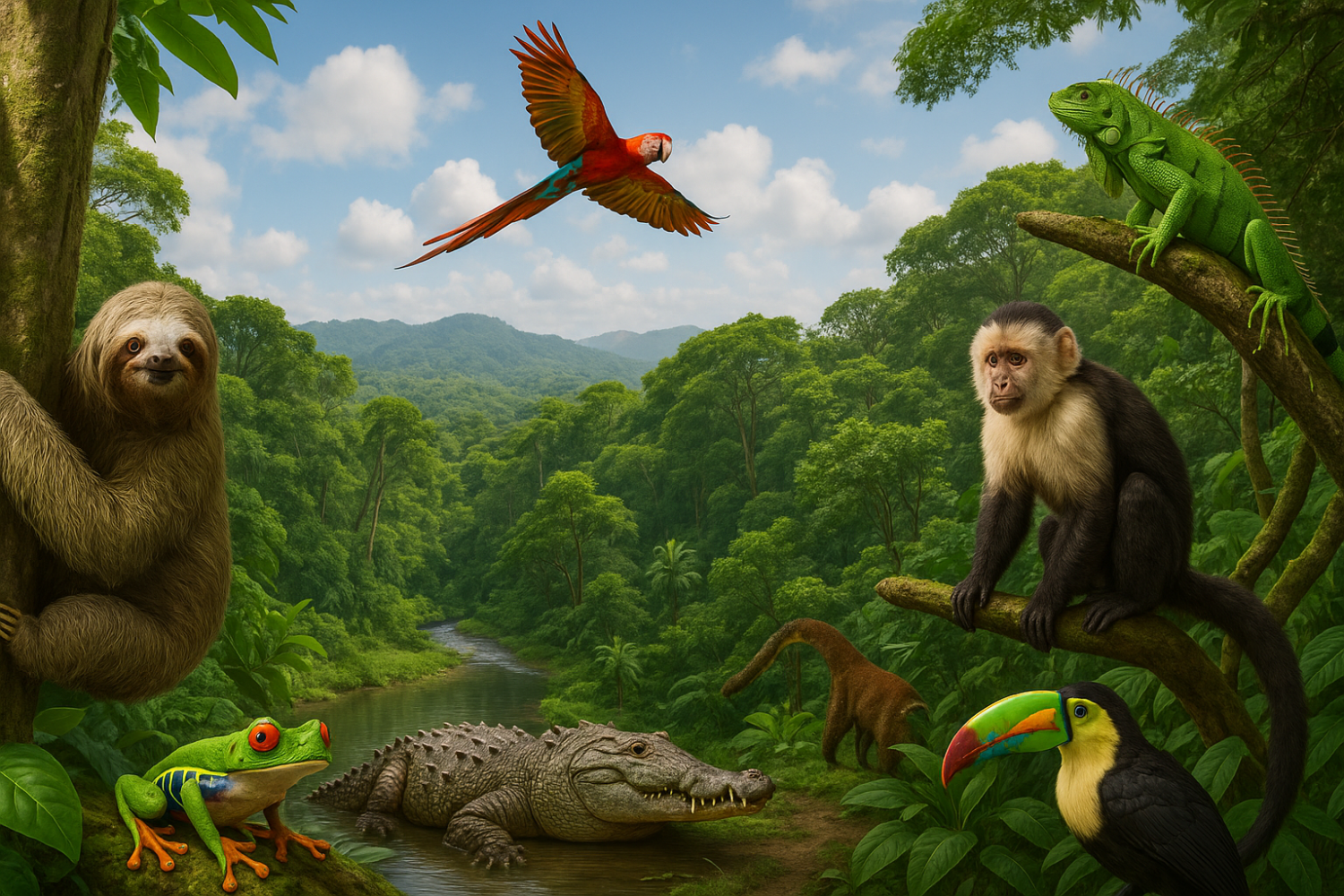In terms of Costa Rica wildlife, we’re talking about one of the world’s great biodiversity hotspots. In a country smaller than West Virginia, you can wake up to howler monkeys, spot macaws on your drive, find a sloth napping above your lunch table, boat past crocodiles in the afternoon, and look for glowing frog eyes on a rainforest night walk. Did I mention the toucan and parrots flying around casually?
The country’s conservation model protects over a quarter of its land, which means casual visitors—no matter your budget—can experience real, living rainforest without needing a biology degree or a month-long expedition.
Below is a practical breakdown of the animals you’re most likely to see, where to aim your time, and the ethical ways to interact that actually help.
Costa Rica Wildlife: Mammals You’re Likely To See
Sloths (two-toed and three-toed): The unofficial mascot of Costa Rica. Look for well-camouflaged “brown soccer balls” wedged into crooks of cecropia and beach almond trees. They’re most commonly spotted in the Caribbean lowlands (Cahuita, Puerto Viejo), Central Pacific (Manuel Antonio), and Arenal/La Fortuna corridors.
Monkeys:
- Mantled howler monkeys (the alarm clock you didn’t ask for). You’ll hear them before you see them.
- White-faced capuchins (curious, quick, often near beaches and picnic areas—don’t feed them).
- Spider monkeys (athletic canopy specialists; more common in less disturbed forests like the Osa Peninsula).
- Squirrel monkeys (tiny, photogenic, and easiest around Manuel Antonio and parts of the South Pacific).
Coatis & agoutis: Coatis look like long-nosed raccoons with tails held upright; agoutis are rabbit-sized, nut-loving rodents you’ll catch darting through leaf litter near trails and lodge gardens.
Anteaters & kinkajous: Giant and lesser anteaters turn up on night drives and lowland forest edges; kinkajous (the honey bear) are a night-walk special—look for big eyeshine high in fruiting trees.
Tapirs (Baird’s): Costa Rica’s largest land mammal. Best odds are in Corcovado National Park and the northern Caribbean wetlands (Caño Negro/Barra del Colorado). Consider guided hikes to boost your chances.
Big cats (jaguar, puma, ocelot): They’re there, but sightings are rare and mostly deep-forest luck moments. You’re more likely to see tracks than the cat itself.
Costa Rica Wildlife: Birds That Steal the Show
Macaws: Scarlet macaws are common across the Central & South Pacific (Tarcoles, Carara, Manuel Antonio, Osa). Great green macaws favor the northern Caribbean lowlands and Sarapiquí.
Toucans & aracaris: Keel-billed and yellow-throated toucans are regulars at dawn/dusk edges and lodge gardens that plant fruiting trees.
Resplendent quetzal: Cloud forest royalty. Book a dawn birding walk in Monteverde or San Gerardo de Dota during fruiting seasons for your best shot.
Hummingbirds by the dozen: Feeders in Monteverde and highland lodges deliver frame-filling looks without chasing them through the forest.
Shore & wetland species: Herons, egrets, jacanas, and kingfishers thrive in Caño Negro, Tortuguero’s canals, and mangroves along the Pacific.
Costa Rica Wildlife: Reptiles, Amphibians & Crocodiles
Crocodiles & caimans: The Tarcoles River is famous for massive American crocodiles; mangrove boat tours showcase them safely from the water.
Iguanas & basilisks: Green iguanas bask on branches and rooftops; “Jesus Christ” basilisks sprint across water along stream margins.
Frogs: You’ll hear the rainforest before you see it. Red-eyed tree frogs are the poster child; glass frogs and poison dart frogs (like strawberry dart frogs in the Caribbean) light up guided night walks.
Sea turtles: Green and hawksbill turtles nest in Tortuguero (Caribbean). Olive ridleys arrive in synchronized waves called arribadas on the Pacific (Ostional/Nosara region). Leatherbacks appear in select sites in both oceans. Book guided, red-light, low-impact night tours when in season.
Costa Rica Wildlife: Marine Life & Coastal Encounters
Whales & dolphins: Humpback whale watching around Uvita/Marino Ballena is a highlight (there are multiple migratory populations, creating a long seasonal window). Spotted and bottlenose dolphins are common in Golfo Dulce and Nicoya.
Snorkeling: Cahuita National Park’s reef (Caribbean) and the South Pacific’s rock/island sites host colorful reef fish and, occasionally, rays and sea turtles. Go with licensed guides and skip days with poor visibility to avoid damaging coral.
Where To Aim Your Time (By Region & Experience)
Manuel Antonio (Central Pacific): High odds for sloths, squirrel monkeys, capuchins, iguanas, macaws, and coast-plus-forest variety—great for first-timers.
Arenal/La Fortuna: Night walks, hanging bridges, and easy access to rain-to-cloud forest transitions for frogs, birds, and monkeys.
Monteverde: Cloud forest birds (quetzal), hummingbird feeders, and canopy walks in cool highlands.
Caribbean South (Cahuita, Puerto Viejo): Sloths, howlers, toucans, dart frogs, plus reef snorkeling when seas are calm.
Osa Peninsula/Corcovado: The country’s wildest megafauna zone—tapirs, scarlet macaws, four monkey species, and big-forest energy.
Sarapiquí & Caño Negro: Birding and wetland wildlife with fewer crowds; boat the backwaters for kingfishers, herons, and caimans.
Tarcoles & Carara: Crocodile river safaris and macaw flyovers near the highway—easy add-on between San José and the Pacific.
Costa Rica Wildlife Activities That Are Worth Your Time
Guided night walks: The single best value experience in rainforest travel. Frogs, insects, snakes, sleeping birds, and the occasional kinkajou—your guide’s headlamp skills make the difference.
Mangrove & canal boat tours: Glide through mangroves (Damas near Quepos, Sierpe on the South Pacific, Tortuguero’s canals on the Caribbean). Birds, monkeys, and reptiles with zero trail fatigue.
Hanging bridges & canopy walks: Arenal and Monteverde deliver switch-up viewpoints—toucans eye-level, monkeys crossing, and epiphytes everywhere.
Birding mornings: Even if you’re not a birder, a 2–3 hour guided session around your lodge garden can net toucans, motmots, trogons, and tanagers you’d walk past on your own.
Turtle nesting tours (in season): Strictly regulated, red-light only, and guide-led. This is conservation tourism done right when you choose certified operators.
Whale & dolphin watching: Small-boat trips out of Uvita, Drake Bay, and Golfo Dulce focus on responsible approaches and engine-off hangs when animals are near.
Ethical Sanctuaries & Rescue Centers (Do Good, Learn More)
If you want an up-close learning experience that supports real Costa Rica wildlife rescue, choose facilities focused on rescue–rehab–release (not photo ops, not petting).
Toucan Rescue Ranch (near San José): A respected rescue and rehabilitation project known for birds, sloths, and education programs. Public “educational walks” support vet care and rewilding work.
Jaguar Rescue Center (Puerto Viejo, Caribbean): A temporary/permanent home for injured and orphaned wildlife—sloths, monkeys, birds, reptiles—with strong veterinary care and releases into protected forest.
Rescate Wildlife Rescue Center (Alajuela; formerly “Zoo Ave”): One of the oldest and largest operations in the country, with active rehab, lifetime care for non-releasable animals, and public education.
Alturas Wildlife Sanctuary (Dominical, South Pacific): Non-profit dedicated to rescue, rehab, and release with guided tours that fund care for native species.
Important: Legit rescues and Costa Rican regulations do not allow visitors to hold or touch sloths and other Costa Rica wildlife. If a place offers sloth-holding, that’s a red flag—skip it.
Eco & Animal Support Groups To Know
If you want your visit to leave a positive footprint on Costa Rica wildlife, support organizations focused on habitat, science, and species recovery:
Sea turtle conservation projects: Community-led groups on both coasts run guided, low-light nest patrols and hatchling releases (book locally and legally).
Reforestation & corridor projects: Volunteer half-days planting native trees near protected areas; ask your lodge who they partner with.
Local wildlife hotlines & rescue networks: Many lodges post contact info for regional rescue partners—donations keep fuel in trucks and vets on call.
Citizen science: Bird counts and frog audio surveys are sometimes offered through lodges and NGOs—great for families.
How To Be A Costa Rica Wildlife Smart Traveler In Costa Rica
- Hire certified local guides: Your sightings will skyrocket and your impact will drop.
- Keep distance, keep it quiet: If an animal is staring at you or changing behavior, you’re too close.
- No feeding, ever: It leads to disease transfer, aggression, and shorter lifespans.
- Ditch the flash: Flash harms nocturnal species and ruins your neighbor’s night vision on walks.
- Choose ethical operators: Look for small groups, red-light rules at night, no handling, and clear conservation messaging.
- Time your wildlife days: Early mornings and just before dusk (golden hours) beat the midday lull. Night belongs to frogs, insects, and tree-dwelling mammals.
Sample 7-Day Costa Rica Wildlife Itinerary
Day 1–2: Arenal/La Fortuna – Hanging bridges at dawn, sloth/monkey odds on mid-elevation trails, guided night walk for frogs and snakes.
Day 3–4: Caribbean South (Cahuita/Puerto Viejo) – Reef snorkeling (if calm), coastal forest strolls for sloths and howlers, visit Jaguar Rescue Center for education and impact. jaguarrescue.foundation
Day 5–6: Central Pacific (Manuel Antonio/Quepos) – Macaws in flight, squirrel monkeys on park trails, mangrove boat tour for kingfishers and basilisks.
Day 7: San José area – Toucan Rescue Ranch or Rescate Wildlife Rescue Center before your flight for a meaningful, educational close. toucanrescueranch.org+1
Swap in Monteverde (quetzal + hummingbirds) or the Osa Peninsula (wild megafauna) if you’ve got more days and want deeper rainforest.
What To Pack (Costa Rica Wildlife Edition)
- Binoculars (8x or 10x) and a headlamp with a red setting for night walks.
- Breathable long sleeves & pants for bugs and evening chill in the highlands.
- Lightweight rain shell and quick-dry layers—downpours happen.
- Trail shoes or closed-toe sandals with grip; muddy roots are part of the deal.
- Dry bag for phones/cameras on boat tours.
- Reusable water bottle—you’ll sweat more than you think.
Responsible Photography Tips
- Use longer focal lengths (200mm+) so you don’t crowd wildlife.
- Wait out behavior rather than chasing it; animals resume natural actions if you stay still.
- For night walks, learn your guide’s light etiquette: red light to find, white light briefly and indirectly if the guide approves, never for sensitive species.
Quick Planning Notes
- You don’t need a decade of Spanish, but learn basic Costa Rica wildlife words (perezoso = sloth, rana = frog, tucán = toucan, delfín = dolphin).
- Self-driving is common; use Waze for real-time road intel and pad your time for rain and bridges.
- Book turtle tours and whale trips with certified operators in season; ask your hotel who they trust.
- If you want to volunteer, vet programs carefully—good ones train you, don’t hand you a sloth.
Five Stellar, Ethical Costa Rica Wildlife Stops (Recap)
- Jaguar Rescue Center (Caribbean): Transparent tours, strong vet care, real releases. jaguarrescue.foundation
- Toucan Rescue Ranch (near San José): Education-first tours funding rescue, rehab, and rewilding. toucanrescueranch.org
- Rescate Wildlife Rescue Center (Alajuela): Decades of rescue work and lifetime care when release isn’t possible. Rescate Wildlife Rescue Center – Zoave
- Alturas Wildlife Sanctuary (South Pacific): Small-group, conservation-driven tours supporting active rehab. Alturas Wildlife Sanctuary
- Tarcoles River (Central Pacific): Boat with licensed guides for crocs and shorebirds—classic, dramatic wildlife from a safe distance. (Ask your hotel for reputable operators.)
Reminder: No sloth holding. Legit centers and national rules prohibit it. If someone offers it, that’s your sign to walk away.
FAQ: Costa Rica Wildlife & Sanctuaries
Q: What’s the best season for wildlife?
A: There’s wildlife year-round. Dry season (roughly Dec–April) brings easier travel and lower vegetation for spotting; green season (May–Nov) offers lush forests and amazing frog action. Whales and turtles depend on regional windows—ask locally when you book.
Q: Can I see sloths in the wild without a guide?
A: Yes—especially along the Caribbean and Central Pacific—but a guide’s trained eye turns “maybe one sloth” into “multiple species plus a tree full of life.”
Q: Are wildlife sanctuaries legit or just zoos?
A: The ethical ones are rescue–rehab–release operations with vet teams, limited handling, and clear policies (see TRR, JRC, Rescate, Alturas). They exist to get animals back to the wild when possible and to provide lifetime care only when necessary.
Q: Can my kids hold a sloth for a photo?
A: No. That’s stressful and harmful for the animal, and reputable centers (and Costa Rican conservation rules) don’t allow it. Choose photos at a respectful distance.
Q: If I only have one Costa Rica wildlife day, what should I book?
A: A guided morning hike plus a night walk. That combo covers diurnal and nocturnal worlds and delivers the most species per hour.
Q: How can I support animals beyond buying a tour?
A: Donate to or visit reputable rescues (listed above), join a certified turtle patrol in season, plant native trees with local groups, and keep your trip plastic-lite.
Costa Rica wildlife watching is easy if you plan a little and keep it ethical. Split your time between a rainforest base (Arenal/Monteverde or the Caribbean/Osa) and a coastal zone, book at least one night walk, and support rescues that prioritize animals over selfies.
After a fun Costa Rica trip, you’ll be set to go home with a camera roll full of wild moments—and the confidence you did it the right way.







